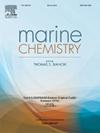Advanced deep learning technique for estimating global surface ocean calcium carbonate saturation (Ωcal)
IF 2.5
3区 地球科学
Q2 CHEMISTRY, MULTIDISCIPLINARY
引用次数: 0
Abstract
The accurate estimation of surface ocean calcium carbonate saturation (Ωcal) is crucial for understanding the impacts of ocean acidification (OA) on marine ecosystems, particularly for calcifying organisms. This study investigates the estimation of global surface ocean Ωcal using machine learning (ML) models and satellite-derived data. Three ML models such as feed-forward neural networks (FFNN), random forests (RF), and Tabularnet (TabNet) were employed to estimate Ωcal, utilizing in-situ and satellite measurements of sea surface temperature (SST), sea surface salinity (SSS), and Chlorophyll-a concentration (Chla). Among these, the TabNet model exhibited superior performance, with a root-mean-square error (RMSE) of 0.39, mean relative error (MRE) of 0.019, mean normalized bias (MNB) of 0.0058 and coefficient of determination (R2) of 0.96. SST showed a strong positive correlation with Ωcal (r = 0.95), while SSS and Chla exhibited moderate positive (r = 0.49) and weak negative (r = −0.27) correlations, respectively. The study revealed significant spatiotemporal variability in Ωcal, driven by seasonal changes and ocean circulation patterns. Sensitivity analysis highlighted the robustness of the TabNet model, maintaining high predictive capability despite variations in SST, SSS, and Chla. The TabNet model high accuracy provides a valuable tool for monitoring and forecasting changes in ocean chemistry, informing conservation efforts and policy-making. This study emphasizes the importance of advanced ML models in marine science and their potential for enhancing our understanding of global oceanic processes.

估算全球海洋表面碳酸钙饱和度的先进深度学习技术(Ωcal)
准确估计海洋表面碳酸钙饱和度(Ωcal)对于了解海洋酸化(OA)对海洋生态系统的影响,特别是对钙化生物的影响至关重要。本研究利用机器学习(ML)模型和卫星衍生数据研究了全球表面海洋Ωcal的估计。采用前馈神经网络(FFNN)、随机森林(RF)和Tabularnet (TabNet) 3种ML模型,利用现场和卫星测量的海面温度(SST)、海面盐度(SSS)和叶绿素-a浓度(Chla)估算Ωcal。其中,TabNet模型表现较好,均方根误差(RMSE)为0.39,平均相对误差(MRE)为0.019,平均归一化偏差(MNB)为0.0058,决定系数(R2)为0.96。SST与Ωcal呈强正相关(r = 0.95), SSS与Chla呈中正相关(r = 0.49),弱负相关(r = - 0.27)。该研究揭示了Ωcal在季节变化和海洋环流模式的驱动下存在显著的时空变异。敏感性分析强调了TabNet模型的稳健性,尽管SST、SSS和Chla存在变化,但TabNet模型仍保持较高的预测能力。高精度的TabNet模型为监测和预测海洋化学变化提供了有价值的工具,为保护工作和决策提供了信息。这项研究强调了先进的ML模型在海洋科学中的重要性,以及它们对增强我们对全球海洋过程的理解的潜力。
本文章由计算机程序翻译,如有差异,请以英文原文为准。
求助全文
约1分钟内获得全文
求助全文
来源期刊

Marine Chemistry
化学-海洋学
CiteScore
6.00
自引率
3.30%
发文量
70
审稿时长
4.5 months
期刊介绍:
Marine Chemistry is an international medium for the publication of original studies and occasional reviews in the field of chemistry in the marine environment, with emphasis on the dynamic approach. The journal endeavours to cover all aspects, from chemical processes to theoretical and experimental work, and, by providing a central channel of communication, to speed the flow of information in this relatively new and rapidly expanding discipline.
 求助内容:
求助内容: 应助结果提醒方式:
应助结果提醒方式:


